Readers Question: would you please explain to me how we can have no inflation, or low inflation if the government injects two or three trillion dollars in the US economy and output falls?
This is an interesting question. Although printing more money tends to cause inflation, there are circumstances where you can increase the money supply without causing inflation.
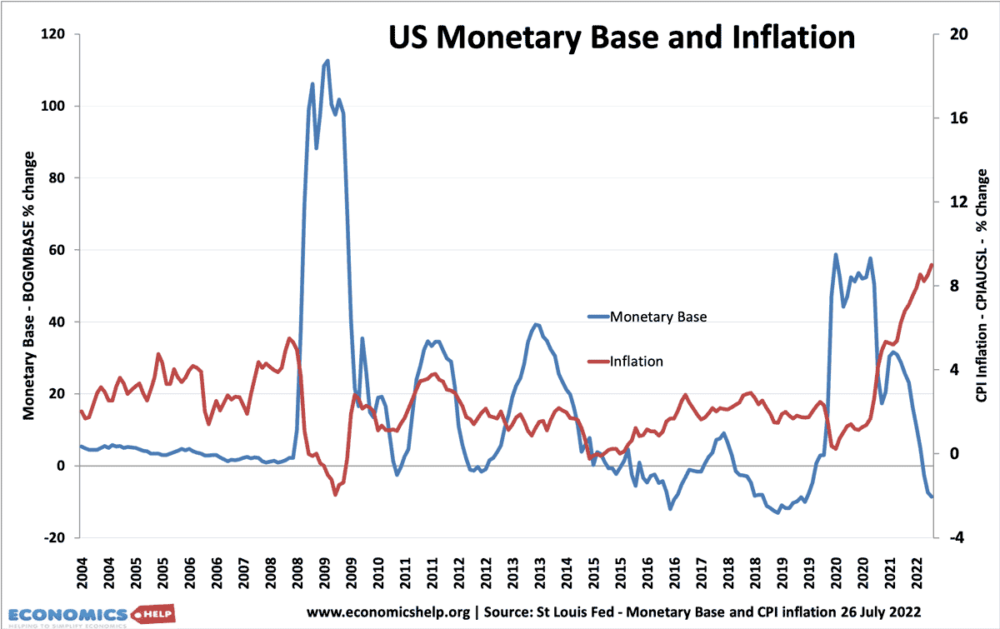
- In 2009/10, there was a significant increase in the monetary base. But, inflation remained very low.
- In 2020/21 the Federal Reserve pursued another increase in the monetary base (during Covid slowdown) but this did lead to inflation 12 months later. (though there were other factors, such as higher oil prices, post-covid supply issues.)
Why increasing money supply may not cause inflation
In a depression, even though the money supply increases, firms and consumers may not go out and spend it. They save it and/or pay off debts and use it to meet a fall in income. Therefore, although the supply of money is increased, the amount of money circulating around the economy can still be falling. A good example is Japan, who between 1990s and 2020s have had a long period of deflation. Even efforts to increase the money supply have often failed to cause significant inflation.
Also, what counts is not just the amount of money (i.e. how many $10 bills you have), but how often it is used. In normal times, if you gave every citizen $1,000 they would go out and buy more luxuries – this could be inflationary. But, in the circumstance of recession, if you gave households $1,000 there would be no surge in demand as there is a preference to save.
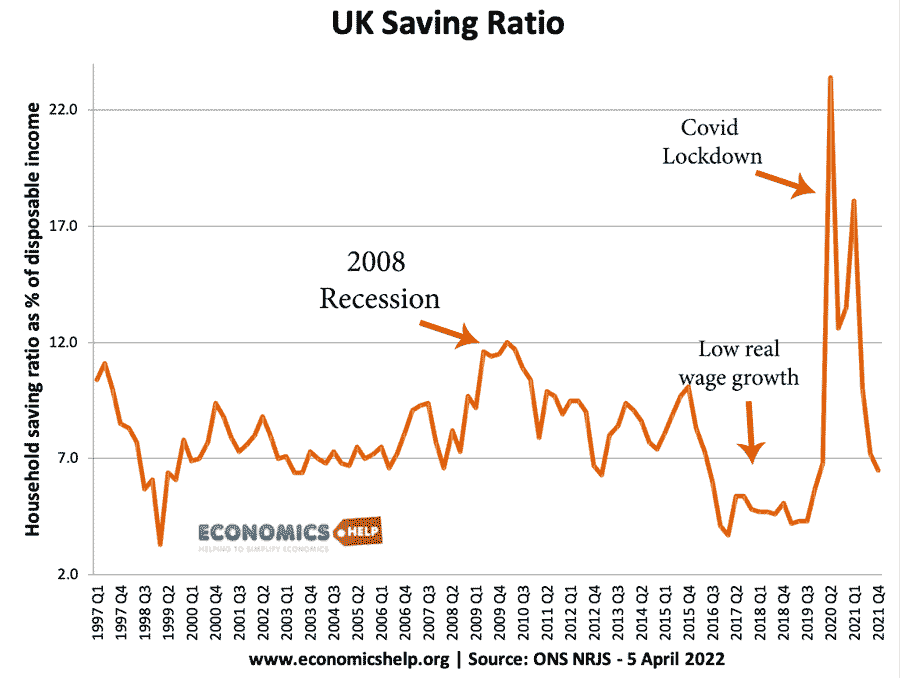
During 2008 recession, saving increased, and also in Covid Lockdown.
Quantitative easing and inflation
Quantitative easing involves the Central Bank creating more money and buying bonds from private banks. This increases the monetary base (M0). But, a key factor is whether the increase in the money supply finds its way into the economy.
During quantitative easing 2009-10, the US Federal Reserve increased the monetary base by over 100%. QE involved Central Bank buying bonds from banks. Therefore commercial banks benefited from an increase in their cash reserves, but banks did not want to lend any of this new cash to consumers. (due to low confidence and losses of credit crunch). Therefore, although the monetary base rose, the wider money supply didn’t.
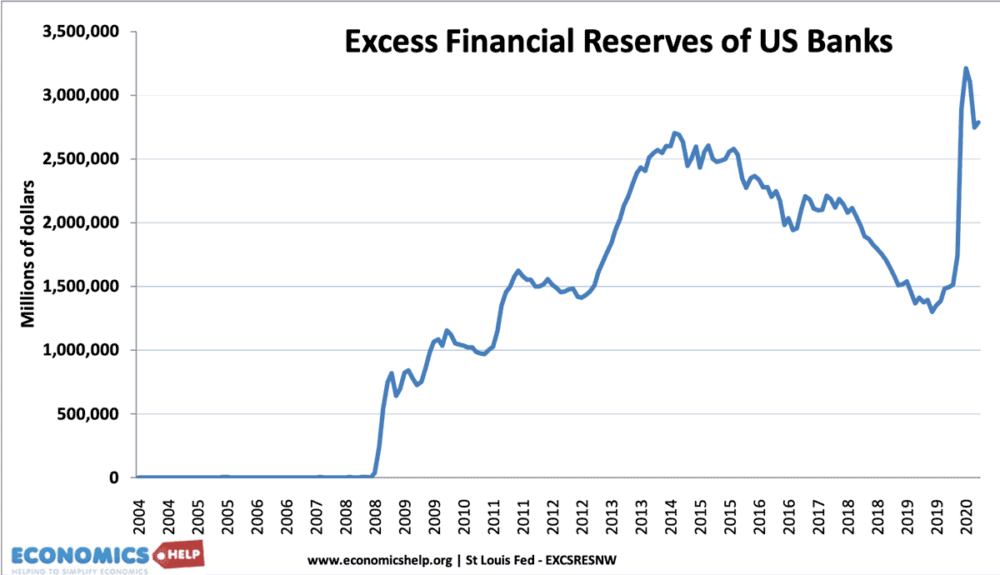
This shows how quantitative easing in 2009/10 led to a large increase in financial reserves for banks. This explains why the expansion of the monetary base (M0) did not cause an increase in the broader money supply and cause inflation.
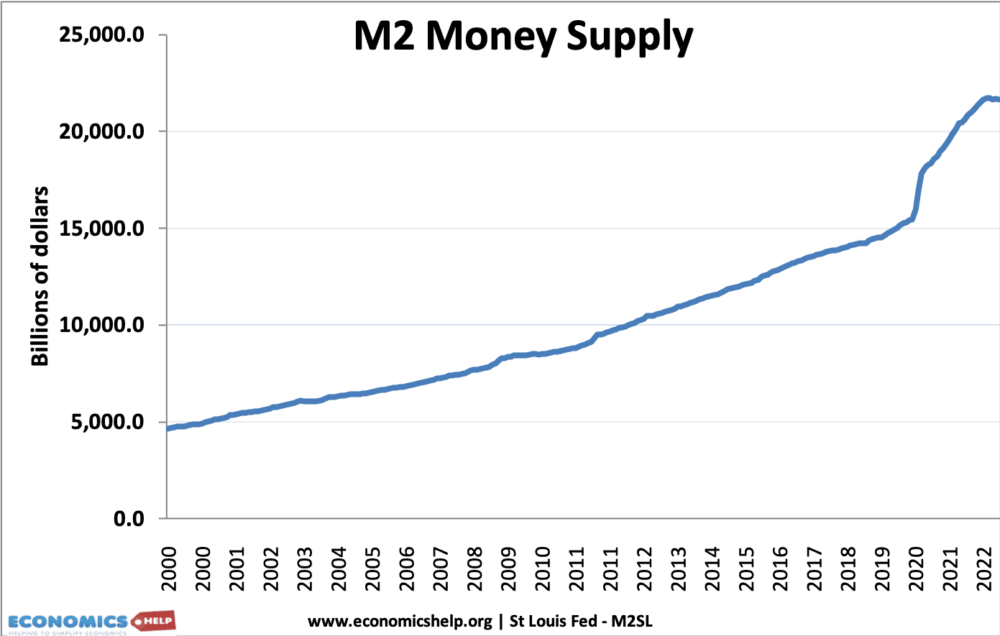
However, the interesting thing is that in 2020/21 an increase in the monetary base did cause higher economic growth, a rise in M2 and inflation.
(Note: Quantitative easing is not quite the same as printing cash and giving to households)
Why printing money usually causes inflation
In normal circumstances (e.g. economy close to full capacity) if the Central Bank printed more money and the number of goods remains the same, we will get higher prices.
Why increasing money supply causes inflation
- Because consumers have more money they want to buy more goods.
- Firms see a rise in demand and so put up prices to ration demand.
- The number of goods remains the same, they are just more expensive.
This seems quite logical but, the difference is that economic circumstances are now very different/
More detail on why printing money might not cause inflation
The quantity theory of money seeks to establish this connection with the formula MV=PY. Where
- M= Money supply,
- V= Velocity of circulation (how many times money changes hands)
- P= Price level
- Y= National Income (T = number of transactions)
If the Central Bank pursues quantitative easing, Money Supply (M) increases
If V (velocity of circulation) and Y (output) stayed constant, Price level (P) would increase.
Related

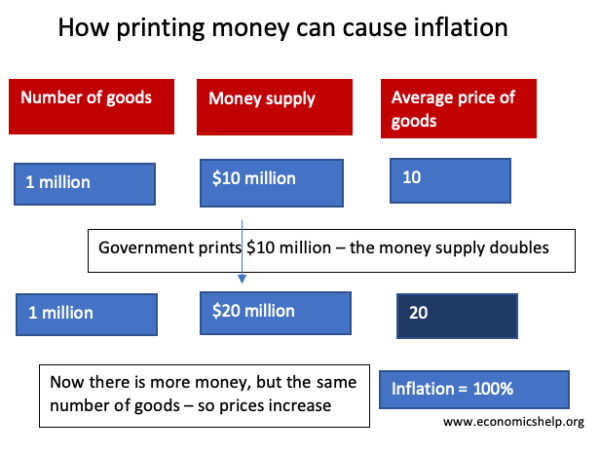
The cause of this economic crisis is from the supply side. Most economic crises, like the Great Depressions of 1873 and 1929, were caused by shortage of demand. Now, demand is not lacking
@Anishur Rahman
Due to this supply-side shock, production-sides are laying off their workers in order to reduce their firms’ expenses. These lay-offs are boosting up the unemployment rate in the economy which is creating a downward pressure on consumers’ spending (C).
Hence, along with supply-side shock, the economy is experiencing a demand-side shock as well.
Correct me if I am wrong. This article states printing money helps prevent deflation. Is that not the same thing as saying printing money causes inflation?
Technicaly speaking, yes. However, I believe the author is referencing uncontrollable or levered inflation. Fundamentally printing money is inflationary. And in this case, it is a balancing act to stabilize the deflationary state of the economy. Correct me if I’m wrong as well haha.
The inflation generated by printing money is balancing the deflation currently happening, so they both cancel each other. So technically printing money in this situation DOES NOT cause inflation when we look to the overall economic state.
I understand that printing money will cause inflation IF production/output remains unchanged, but is it not possible to print money and simultaneously have government intervention to stimulate production/output and prevent too much inflation?
And what will happen if the supply and demand restores to the 2019 level, but we have this increased amount of money?
In that case there would be an inflation but the purpose is for the government to “get” the extra money back once everything has passed. So taxes will raise after this crisis. This, or productivity must really increase for the products/services to match the money in circulation
What is the consequence of rising oil prices now? In the article you say that falling oil prices will help to stabilize inflation because aggregate supply shifts to the right but now that aggregate supply has dropped due to new US government policies it is having an international effect.
It’s now Jan 2022, and we have our answer: massive money printing causes massive inflation.
This didn’t age well
But, in practise it is very hard for government to increase output.
Firms see a rise in demand and so put up prices to ration demand….. firms put up prices to make more money. rationing demand is an afterthought